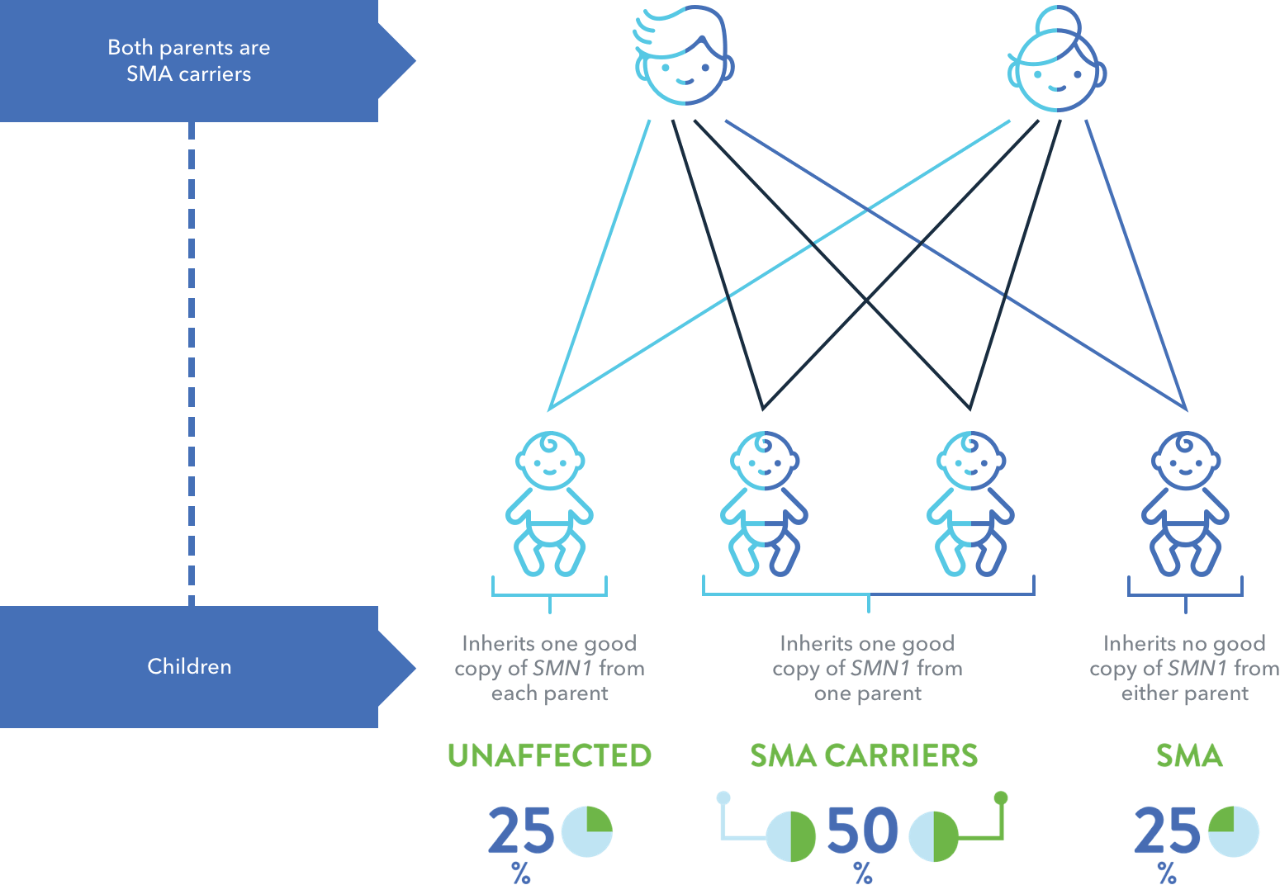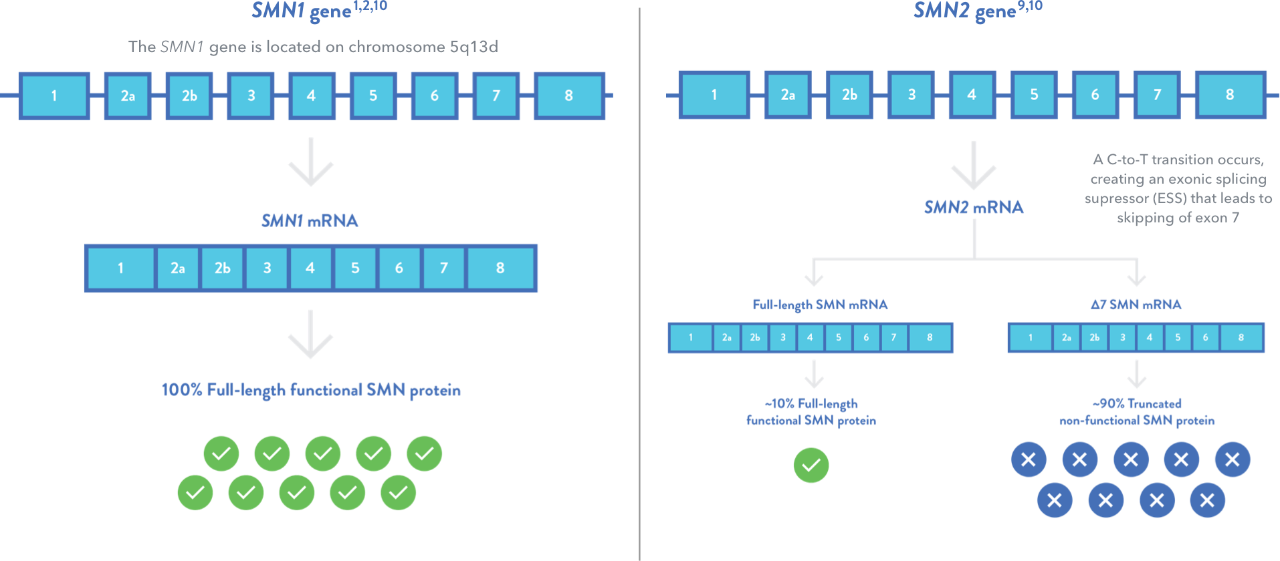


-
Argentina (Español)

-
Australia (English)

-
Bahrain (English)

-
Chile (Español)

-
Deutschland (Deutsch)

-
Europe (English)

-
France (Français)

-
Greece (Ελληνικά)

-
Italia (Italiano)

-
日本 (日本語)

-
대한민국 (한국어)

-
Kuwait (English)

-
Oman (English)

-
Polska (Polskie)

-
Qatar (English)

-
Saudi Arabia (English)

-
Spain (Español)

-
Sverige (Svenska)

-
台灣 (中文)

-
United States (English)

-
UAE (English)

Genetics in SMA
SMA is a hereditary disease with a well-characterised genetic cause.1-3
SMA is an autosomal recessive genetic disease in which an individual inherits two deleted or mutated SMN1
genes — one from each parent:1-3


Noncarriers of SMA have 2 copies of the SMN1 gene, one on each chromosome5. Individuals are defined as carriers if they have genetic patterns which may include:
- 1 copy of the SMN1 gene on one chromosome and 0 copies on the other
- 2 copies of the SMN1 gene on one chromosome and 0 copies on the other
The genetic deficit underlying SMA is well characterised
The role of the survival motor neuron 1 (SMN1) gene is to produce SMN protein,
a protein essential for motor neuron survival and which is highly expressed in the
spinal cord.2,3
In SMA, homozygous mutations or deletions of the SMN1 gene produce a shortage of SMN protein, which causes degeneration of motor neurons in the spinal cord.1,6
Nearly all people, including those with SMA, have a second, virtually duplicate gene to SMN1, known as the survival motor neuron 2 (SMN2) gene7,8
- SMN2 gene is nearly identical in genomic sequence to the SMN1 gene, differentiated by just 5 nucleotides1
- However, a C-to-T nucleotide change in the SMN2 gene creates an exonic splicing suppressor (ESS) that leads to a skipping of exon 7 during transcription9
- This results in the SMN2 gene producing a truncated, non-functional, and rapidly degrading unstable protein9


Approximately 10% of SMN2 transcripts result in
full-length SMN protein. This amount is insufficient to sustain survival of spinal motor neurons in the CNS.9
Generally, the number of SMN2 gene copies is inversely related to the severity of SMA
SMN2 gene copy numbers are variable in individuals with SMA. Higher numbers typically correlate with less severe disease:8,9
- More than 95% of individuals with SMA retain at least 1 copy of the SMN2 gene
- About 80% of individuals with Type I SMA have 1 or 2 copies of the SMN2 gene
- About 82% of individuals with Type II SMA have 3 copies of the SMN2 gene
- About 96% of individuals with Type III SMA have 3 or 4 copies of the SMN2 gene
The SMN2 gene copy number is related to, but not predictive of, disease severity. Care decisions should not be made based on copy number alone11,12
In any case of SMA, SMN2 gene copy number is less predictive of prognosis than age of onset and the achievement of functional abilities13
In addition to the SMN2 gene, there is some evidence of other genetic modifiers of disease severity, including levels of the protein Plastin-311
- Lefebvre S et al. Cell 1995; 80: 155–65.
- Kolb SJ and Kissel JT. Arch Neurol 2011; 68: 979–84.
- Lunn MR and Wang CH. Lancet 2008; 371: 2120–33.
- National Organization for Rare Diseases. Spinal muscular atrophy. Available at: http://rarediseases.org/rarediseases/spinal-muscular-atrophy. Accessed November 2017.
- Prior TW. Obstet Gynecol Clin N Am 2010; 37: 23–36.
- Genetics Home Reference. SMN1. https://ghr.nlm.nih.gov/gene/SMN1. Published October 17, 2017. Accessed October 2017.
- Swoboda KJ. N Engl J Med 2014; 371: 1752–4.
- Fang P et al. BMC Musculoskelet Disord 2015;16:1–8.
- Darras BT et al. Neuromuscular Disorders of Infancy, Childhood, and Adolescence: A Clinician’s Approach. 2nd ed. London, UK: Elsevier; 2015.
- Ogino S and Wilson RB. Expert Rev Mol Diagn 2004; 4: 15–29.
- Butchbach M. Front Mol Biosci 2016; 3: 7.
- TREAT-NMD. Diagnostic testing and care of new SMA patients. http://www.treat-nmd.eu/downloads/file/standardsofcare/sma/english/sma_soc_en.pdf. Accessed October 2017.
- Prior TW et al. Am J Hum Genet 2009; 85: 408–13.
